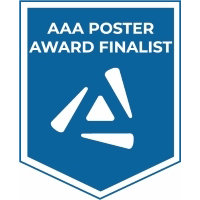Back
ANATOMY
Category: Anatomy
Session: 474 Anatomy Education
(474.4) An Exploration of Metacognitive Practices in Gross Anatomy Educators
Sunday, April 3, 2022
10:15 AM – 12:15 PM
Location: Exhibit/Poster Hall A-B - Pennsylvania Convention Center
Poster Board Number: C4
Introduction: AAA has separate poster presentation times for odd and even posters.
Odd poster #s – 10:15 am – 11:15 am
Even poster #s – 11:15 am – 12:15 pm
Introduction: AAA has separate poster presentation times for odd and even posters.
Odd poster #s – 10:15 am – 11:15 am
Even poster #s – 11:15 am – 12:15 pm
Andrew Cale (Indiana University School of Medicine), Margaret McNulty (Indiana University School of Medicine)
Andrew S. Cale, MS
Ph.D. Candidate
Indiana University School of Medicine
Indianapolis, Indiana
Presenting Author(s)
Introduction: Metacognition, the ability to monitor and regulate one’s thought processes, has been shown to benefit instructors by improving their effectiveness as teachers. Particularly with dissection-based gross anatomy, instructors are dynamically using metacognitive processes to monitor student learning and adapt teaching strategies at table-side. Therefore, the purpose of this study was to explore the metacognitive processes of gross anatomy instructors as they taught in an anatomy course for allied health students.
Methods: All instructors in a doctoral-level dissection-based gross anatomy course, including faculty, associate instructors (AIs), and near-peer teaching assistants (TAs), were invited to participate in this IRB-approved study. All instructors participated in facilitating lab dissections. At the start and end of the course, instructors were invited to complete pre- and post-questionnaires which included the Teacher Metacognition Inventory (TMI), a 28-item survey that assesses metacognition as it relates to teaching. Pre- and post-TMI scores were analyzed using Wilcoxon Signed Rank and Kruskal-Wallis H tests. After the dissection labs, instructors who were in attendance were asked to complete reflective journals to provide deeper insight into their metacognitive processes. Topics included self-evaluations of teaching, emotions associated with teaching, and plans for future teaching sessions. Reflective journals were thematically analyzed using both deductive and inductive coding.
Results: All seven female instructors participated in this study, including two faculty, one AI, and four TAs (54% of instructors in the course). Due to the small number of participants, statistical significance could not be calculated for all tests. Between the start and end of the course, total TMI score increased from 106.9 to 114.0. TAs exhibited the greatest increase in total TMI score (Δmean=13.3) followed by the AI (Δmean=3.5) and faculty (Δmean=2.5). In the pre-questionnaire, TAs, AIs, and faculty exhibited the greatest difference in Metacognitive Knowledge of Self. However, this difference was reduced in the post-questionnaire, indicating that TAs demonstrated the greatest increase in this parameter. Several specific themes were identified through thematic analysis. For example, TAs were more internally-focused on personal traits and content mastery whereas faculty were externally-focused on interpersonal factors (e.g. student names, inclusive language, etc.).
Conclusion: Overall, gross anatomy instructors improved their metacognition, particularly in relation to the metacognitive knowledge of their own strengths and weaknesses. TAs exhibited the most metacognitive growth while faculty remained consistent, possibly due to a ceiling effect. Upon reflection, TAs tended to focus on personal aspects while faculty focused on interpersonal aspects of teaching.
SIGNIFICANCE: These insights into the metacognitive processes and educational priorities of anatomy instructors can inform how to best support their professional development at different stages in their careers. Novices may benefit more from content reviews while experienced instructors may benefit from pedagogical or communications training.
Support or Funding Information
No funding was received for this study.
Methods: All instructors in a doctoral-level dissection-based gross anatomy course, including faculty, associate instructors (AIs), and near-peer teaching assistants (TAs), were invited to participate in this IRB-approved study. All instructors participated in facilitating lab dissections. At the start and end of the course, instructors were invited to complete pre- and post-questionnaires which included the Teacher Metacognition Inventory (TMI), a 28-item survey that assesses metacognition as it relates to teaching. Pre- and post-TMI scores were analyzed using Wilcoxon Signed Rank and Kruskal-Wallis H tests. After the dissection labs, instructors who were in attendance were asked to complete reflective journals to provide deeper insight into their metacognitive processes. Topics included self-evaluations of teaching, emotions associated with teaching, and plans for future teaching sessions. Reflective journals were thematically analyzed using both deductive and inductive coding.
Results: All seven female instructors participated in this study, including two faculty, one AI, and four TAs (54% of instructors in the course). Due to the small number of participants, statistical significance could not be calculated for all tests. Between the start and end of the course, total TMI score increased from 106.9 to 114.0. TAs exhibited the greatest increase in total TMI score (Δmean=13.3) followed by the AI (Δmean=3.5) and faculty (Δmean=2.5). In the pre-questionnaire, TAs, AIs, and faculty exhibited the greatest difference in Metacognitive Knowledge of Self. However, this difference was reduced in the post-questionnaire, indicating that TAs demonstrated the greatest increase in this parameter. Several specific themes were identified through thematic analysis. For example, TAs were more internally-focused on personal traits and content mastery whereas faculty were externally-focused on interpersonal factors (e.g. student names, inclusive language, etc.).
Conclusion: Overall, gross anatomy instructors improved their metacognition, particularly in relation to the metacognitive knowledge of their own strengths and weaknesses. TAs exhibited the most metacognitive growth while faculty remained consistent, possibly due to a ceiling effect. Upon reflection, TAs tended to focus on personal aspects while faculty focused on interpersonal aspects of teaching.
SIGNIFICANCE: These insights into the metacognitive processes and educational priorities of anatomy instructors can inform how to best support their professional development at different stages in their careers. Novices may benefit more from content reviews while experienced instructors may benefit from pedagogical or communications training.
Support or Funding Information
No funding was received for this study.

